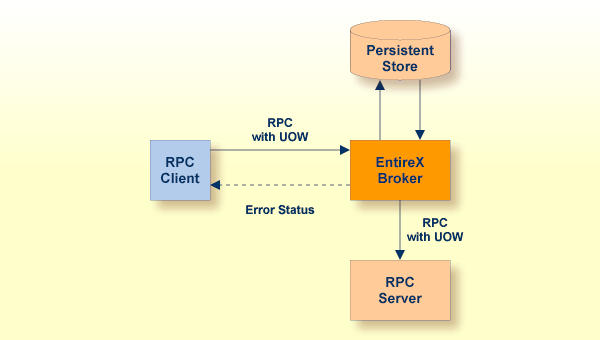In the architecture of modern e-business applications (such as SOA), loosely coupled systems are becoming more and more important. Reliable messaging is one important technology for this type of system.
Reliable RPC is the EntireX implementation of a reliable messaging system. It combines EntireX RPC technology and persistence, which is implemented with units of work (UOWs).
Reliable RPC allows asynchronous calls ("fire and forget")
Reliable RPC is supported by most EntireX wrappers
Reliable RPC messages are stored in the Broker's persistent store until a server is available
Reliable RPC clients are able to request the status of the messages they have sent

Reliable RPC is used to send messages to a persisted Broker service. The
messages are described by an IDL program that contains only IN parameters. The
client interface object and the server interface object are generated from this
IDL file, using the EntireX Java Wrapper.
Reliable RPC is enabled at runtime. The client has to set one of two different modes before issuing a reliable RPC request:
AUTO_COMMIT
CLIENT_COMMIT
While AUTO_COMMIT commits each RPC message implicitly after sending it, a
series of RPC messages sent in a unit of work (UOW) can be committed or rolled
back explicitly using CLIENT_COMMIT mode.
The server is implemented and configured in the same way as for normal RPC.
All methods for reliable RPC are available on the interface object. See RPCService for details. The methods are:
RPCService.setReliable
RPCService.getReliable
RPCService.reliableCommit
RPCService.reliableRollback
RPCService.getMessageId
RPCService.getStatusOfMessage
Example (this example is included as source in the examples/RPC/reliable/JavaClient folder):
Create Broker object and interface object.
Broker broker = new Broker(Mail.DEFAULT_BROKERID, userID); Mail mail = new Mail(broker); broker.logon();
Enable reliable RPC with CLIENT_COMMIT
mail.setReliable(RPCService.RELIABLE_CLIENT_COMMIT);
The first RPC message.
mail.sendmail("mail receiver", "Subject 1", "Text 1");
Check the status: get the message ID first and use it to retrieve the status.
String messageID = mail.getMessageID();
String messageStatus = mail.getStatusOfMessage(messageID);
System.out.println("Status: " + messageStatus + ", id: " + messageID);
The second RPC message.
mail.sendmail("mail receiver", "Subject 2", "Text 2");
Commit the two messages.
mail.reliableCommit();
Check the status again for the same message ID.
messageStatus = mail.getStatusOfMessage(messageID);
System.out.println("Status: " + messageStatus + ", id: " + messageID);
The third RPC message.
mail.sendmail("mail receiver", "Subject 3", "Text 3");
Check the status: get the new message ID and use it to retrieve the status.
messageID = mail.getMessageID();
messageStatus = mail.getStatusOfMessage(messageID);
System.out.println("Status: " + messageStatus + ", id: " + messageID);
Roll back the third message and check status.
mail.reliableRollback();
messageStatus = mail.getStatusOfMessage(messageID);
System.out.println("Status: " + messageStatus + ", id: " + messageID);
broker.logoff();
All program calls that are called in the same transaction
(CLIENT_COMMIT) must be in the same IDL library.
It is not allowed to switch from CLIENT_COMMIT to AUTO_COMMIT in a
transaction.
Messages (IDL programs) have IN parameters only.
The server implementation consist of the four classes:
Abstract<IDL library name>Server
<IDL library name>
<IDL library name>Server
<IDL library name>Stub
Add your implementation to the class <IDL library
name>Server. There are no server-side methods for reliable RPC.
The server does not send back a message to the client. The server can run
deferred, thus client and server do not necessarily run at the same time. If
the server fails, it throws an exception. This causes a cancel of the
transaction (unit of work inside the Broker) and the error code is written to
the user status field of the unit of work.
A Broker configuration with PSTORE is recommended. This enables the Broker
to store the messages for more than one Broker session. These messages are
still available after Broker restart. The attributes
STORE, PSTORE,
and PSTORE-TYPE in the Broker attribute file can
be used to configure this feature. The lifetime of the messages and the status
information can be configured with the attributes
UWTIME and
UWSTAT-LIFETIME. Other attributes such as
MAX-MESSAGES-IN-UOW,
MAX-UOWS and
MAX-UOW-MESSAGE-LENGTH may be used in addition
to configure the units of work. See Broker Attributes.
The result of the method
RPCService.getStatusOfMessage depends on the
configuration of the unit of work status lifetime. If the status is not stored
longer than the message, the method returns (not
available).